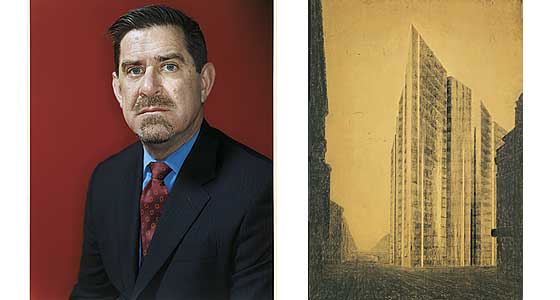
Terence Riley never got to move into his new MoMA office. When he left the museum on March 15 to become director of the Miami Art Museum—where he’ll oversee the construction of a brand-new $200 million building—his Department of Architecture and Design was still in temporary space. But Riley could look down on the minimalist monument he’d helped build and think that when it came to rehabilitating modernism’s reputation, his work here was done. Hard as it may be to believe now, when Riley was hired as architecture curator in 1992, at age 37, people didn’t have Mies Barcelona chairs in their glass-walled high-rise apartments. He’s arguably overseen the development of an aesthetic cliché: the triumph of his taste in an age of mass-market design connoisseurship.
It’s kind of crazy that you’ve got to find a new architect to build another new museum after all you went through with this one. Do you regret hiring Yoshio Taniguchi?
Looking back, if the goal is to excite everyone about the newest, newest, newest, Taniguchi was not that person. But I don’t buy the criticism that we should have gone off and staked out some “bold new territory.” I mean, isn’t it okay that the Uffizi is a Renaissance building and the art is all flowing from that same humanistic moment? I think the art that we have looks great in this building.
Have you always been a modernist?
In 1984, around when I got out of school, it was the heyday of postmodernism. If you really wanted to lose a job quickly, you’d say that you were interested in modern architecture. That was like saying that you were a sex offender.
Why were you resistant to postmodernism?
Well, I grew up in Woodstock, Illinois: redbrick courthouse, white dome, county jail next door. And what’s more, it actually had history. Eugene Debs was tried there. I come from a real premodern town, so postmodernism would never have any interest to me, because of its inherent falseness.
In 1992, before you came to MoMA, you curated a remake of Philip Johnson’s 1932 International Style Show.
Philip was a little ambivalent. It was not exactly in his interest to sign on to a project that was about delivering a defibrillator to modern architecture.
What was he building then?
Deconstruction.
And then you got his old perch at MoMA and started defibrillating more.
Yes. In the early eighties, if you had told me, “You’re going to do a Mies van der Rohe exhibition at MoMA, and there won’t be any visible critic of any stature to speak against it,” I wouldn’t have believed it. And what I realized was that none of the papers had a postmodern critic anymore. I mean, it was still around us. Look at what developers were doing. But there was no force behind it anymore.
Perhaps you’ve won that argument too convincingly.
I don’t think it’s wrong to be a tastemaker. I think it’s wrong to desperately want to be one. Now, if the question is, what is the nature of this tastemaking? Is it just a fad? I think in some instances, it is, like mid-century modernism.
A year before you announced you were leaving MoMA, Nicolai Ouroussoff, the Times’ architecture critic, said your design galleries had “the feel” of “a high-end furniture and design showroom.”
To the extent that design is about consumer goods, for the most part, it’s not about craft. You’re not designing for a prince; it’s about the notion of a middle class. And we value these things for all sorts of reasons, but the fact is, as a grouping, they would resemble a store, because that’s where they come from.
Retail has changed, too.
Yes. It’s interesting, because [Murray] Moss gets a thumbs-up, because he’s managed to make his store look like a museum.
Ouroussoff also wrote that your department lacked leadership and was in Johnson’s shadow. You responded in an open letter that described his “blatantly ad hominem tone” as having “the odor of mendacity.”
Yeah. Well, it was like Philip Johnson just died and he was pulling one of these “I knew Philip Johnson”s … Frankly, I knew him much better than you did, Nicolai. But you know, it’s all water under the bridge.